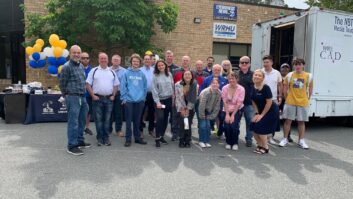MILAN — In an effort to broaden its reach, RTL 102.5 has adopted a unique marketing strategy, which includes enriching its traditional multiplatform audio and video feeds as well as targeting previously untapped audience segments.

Pictured from left are Daniele Suraci, Radio Freccia station manager; Lorenzo Suraci, owner; Eugenio La Teana, head of R&D; and Angelo Gravagno, music programmer and scheduling.
With an audience of about 7 million listeners per day, RTL 102.5 is Italy’s leading national commercial broadcaster, surpassing runner-up Radio Deejay (4.8 million) by more than 2 million listeners.
RTL 102.5 offers a contemporary hit radio format. In order to expand its listenership and to target certain markets, in 2015 the broadcaster acquired multiregional station Radio Zeta, which covers most of Northern Italy. Soon Radio Zeta began broadcasting Italian music only.
LIKE A MOVIE
In autumn 2016, RTL 102.5 also launched Radio Freccia, a digital-only station on DAB, which was a remake of RTL Rock but with a major overhaul.
“We decided not to create a station to target a community of people sharing specific music interests. The idea was to aggregate a community of people around a new station capable of speaking to their gut,” said Lorenzo Suraci, owner of RTL 102.5
The new station was modeled off “radio libere” or “free stations.” This is the common Italian definition for the first generation of local, nonpublic service stations in Italy that began broadcasting in the 1970s.

Presenters Guido Monti (aka Big G), left, and Gigio D’Ambrosio (aka Dick Steel) in the Radio Freccia on-air studio.
The vast majority of these local stations endeavored to nurture political and social discussion, examining themes not previously covered by the public service broadcaster RAI. Presenters often spent the entire day speaking on the mic and granting uncensored space to listeners’ calls.
During this period, concept/music tracks were primarily used as the glue between subsequent thoughts, thus previously uncommon music genres and bands debuted on the country’s airwaves. For Italians growing up during the 1970s to mid 1980s, the radio libere era left a significant mark on their mindset and behavior.
In 1998, Italian rock star Luciano Ligabue directed his first movie, “Radio Freccia” (“Radio Arrow”), a semi-autobiographical story of one of this era’s stations, Radio King, based in Correggio, in the province of Reggio Emilia.
HUMAN TOUCH
“We decided to call our new station ‘Radio Freccia’ as a tribute to Ligabue’s movie,” continued Suraci. “It is a classic rock station, with carefully shaped programming. We designed Radio Freccia to sound similar to radio libere and to deliver the same feeling but with a contemporary taste.”

Program assistant Gigi Qutrì (aka GQ) supervises live feeds in a studio at Radio Freccia.
Radio Freccia leaves aside the political and social talk, as well as the open mics, which were the distinctive feature of the early radio libere, and instead invests a lot in the music discovery function of radio.
“We select and play great rock music,” said Suraci. “Our two music directors individually listen and choose each track to be added to our music list. We don’t rely on computers in this process, we use the human touch.”
Radio Freccia doesn’t only target those who directly experienced the radio libere era. Suraci believes that great rock music is highly inclusive, so Radio Freccia reaches out to a wider audience by playing this type of music and offering a distinctive presenting style.
“Radio Freccia’s presenters have to be true rock enthusiasts,” Suraci explains. “Voice is key in radio, so we pick people with astonishing voices. They also need to have in-depth knowledge of rock music, since we ask them to be very concise when introducing songs — they introduce and music speaks, not vice-versa.”
Suraci personally selects the station’s presenters, who he says range from experienced announcers to absolute beginners. Some are also musicians, actors and voiceover specialists.

The Radio Freccia logo reads “Free, like us.”
FOSTER IMAGINATION
After initial streamlining as a digital-only station, by end 2016 Radio Freccia also began broadcasting on redundant frequencies of RTL 102.5 and, in some zones, of Radio Zeta.
RTL 102.5 has been a pioneer in both visual radio and multiplatform distribution in Europe, and both Radio Zeta and Radio Freccia — broadcasting via FM, DAB, DTV, satellite, the web and a dedicated smartphone app — are no exception to the house style.
“Finding the visual content for each song was a major challenge,” adds Suraci, “because many of them date back to the 1960s and before. But we did it, because we believe visual is key to radio.”
As a tribute to the past, presenters and the studio never appear on Radio Freccia’s visual feed. In fact, almost every presenter on radio libere used an “alias” name, so even people from the same village might not know who the voice belongs to.

“All of the Radio Freccia presenters use an alias, and even if they appear on the Radio Freccia website we never show their face while on air on any visual feed. Radio Freccia has to foster imagination around its iconic background,” Suraci said.
Commercials appear in an innovative way on the Radio Freccia visual feed, with a speech-to-text engine processing the voice message included in commercials. The video playback engine reproduces the captions on the full screen, in sync with the audio.
“It is highly impressive at sight, but it is also great when you are watching at the screen in a noisy environment, like a coffee-bar or an airport,” said Eugenio La Teana, RTL 102.5 technology director. “You couldn’t listen to the message, but you can clearly read it. So you get it.”
Radio Freccia’s visual feed is now also available via the Flipps TV app. “Just one month after we had regular viewers not just from Italy, but also from the United States, Brazil, Russia, France and Sweden,” La Teana concluded.
Davide Moro reports on the industry for Radio World from Bergamo, Italy.












